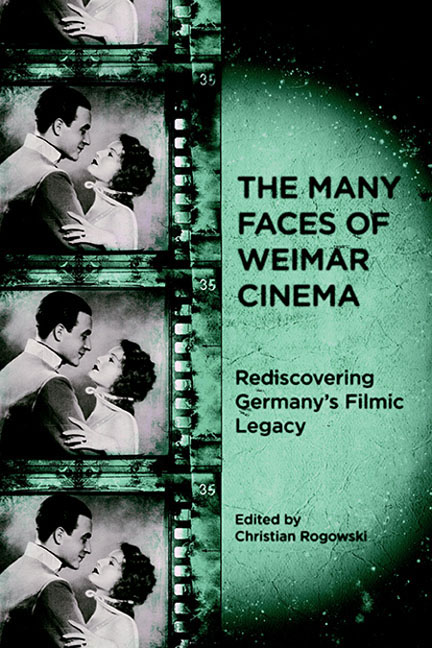Book contents
- Frontmatter
- Contents
- List of Illustrations
- Preface
- Introduction: Images and Imaginaries
- 1 Richard Oswald and the Social Hygiene Film: Promoting Public Health or Promiscuity?
- 2 Unsettling Nerves: Investigating War Trauma in Robert Reinert's Nerven (1919)
- 3 Humanity Unleashed: Anti-Bolshevism as Popular Culture in Early Weimar Cinema
- 4 Desire versus Despotism: The Politics of Sumurun (1920), Ernst Lubitsch's “Oriental” Fantasy
- 5 Romeo with Sidelocks: Jewish-Gentile Romance in E. A. Dupont's Das alte Gesetz (1923) and Other Early Weimar Assimilation Films
- 6 “These Hands Are Not My Hands”: War Trauma and Masculinity in Crisis in Robert Wiene's Orlacs Hände (1924)
- 7 The Star System in Weimar Cinema
- 8 Schaulust: Sexuality and Trauma in Conrad Veidt's Masculine Masquerades
- 9 The Musical Promise of Abstract Film
- 10 The International Project of National(ist) Film: Franz Osten in India
- 11 The Body in Time: Wilhelm Prager's Wege zu Kraft und Schönheit (1925)
- 12 Henrik Galeen's Alraune (1927): The Vamp and The Root of Horror
- 13 The Dialectic of (Sexual) Enlightenment: Wilhelm Dieterle's Geschlecht in Fesseln (1928)
- 14 Babel's Business — On Ufa's Multiple Language Film Versions, 1929–1933
- 15 “A New Era of Peace and Understanding”: The Integration of Sound Film into German Popular Cinema, 1929–1932
- 16 Landscapes of Death: Space and the Mobilization Genre in G. W. Pabst's Westfront 1918 (1930)
- 17 Undermining Babel: Victor Trivas's Niemandsland (1931)
- 18 Unmasking Brigitte Helm and Marlene Dietrich: The Vamp in German Romantic Comedies (1930–33)
- Filmography
- Notes on the Contributors
- Index
2 - Unsettling Nerves: Investigating War Trauma in Robert Reinert's Nerven (1919)
Published online by Cambridge University Press: 29 April 2017
- Frontmatter
- Contents
- List of Illustrations
- Preface
- Introduction: Images and Imaginaries
- 1 Richard Oswald and the Social Hygiene Film: Promoting Public Health or Promiscuity?
- 2 Unsettling Nerves: Investigating War Trauma in Robert Reinert's Nerven (1919)
- 3 Humanity Unleashed: Anti-Bolshevism as Popular Culture in Early Weimar Cinema
- 4 Desire versus Despotism: The Politics of Sumurun (1920), Ernst Lubitsch's “Oriental” Fantasy
- 5 Romeo with Sidelocks: Jewish-Gentile Romance in E. A. Dupont's Das alte Gesetz (1923) and Other Early Weimar Assimilation Films
- 6 “These Hands Are Not My Hands”: War Trauma and Masculinity in Crisis in Robert Wiene's Orlacs Hände (1924)
- 7 The Star System in Weimar Cinema
- 8 Schaulust: Sexuality and Trauma in Conrad Veidt's Masculine Masquerades
- 9 The Musical Promise of Abstract Film
- 10 The International Project of National(ist) Film: Franz Osten in India
- 11 The Body in Time: Wilhelm Prager's Wege zu Kraft und Schönheit (1925)
- 12 Henrik Galeen's Alraune (1927): The Vamp and The Root of Horror
- 13 The Dialectic of (Sexual) Enlightenment: Wilhelm Dieterle's Geschlecht in Fesseln (1928)
- 14 Babel's Business — On Ufa's Multiple Language Film Versions, 1929–1933
- 15 “A New Era of Peace and Understanding”: The Integration of Sound Film into German Popular Cinema, 1929–1932
- 16 Landscapes of Death: Space and the Mobilization Genre in G. W. Pabst's Westfront 1918 (1930)
- 17 Undermining Babel: Victor Trivas's Niemandsland (1931)
- 18 Unmasking Brigitte Helm and Marlene Dietrich: The Vamp in German Romantic Comedies (1930–33)
- Filmography
- Notes on the Contributors
- Index
Summary
Hysteria is an infectious disease.
— Julius von Wagner-Jauregg
Hysteria and Nerven
In the wake of the First World War, an entire generation was saddled with the psychological trauma resulting from the mass death of 10 million soldiers on the battlefield (Winter, 15–53; Keegan, 3). This psychic trauma was particularly felt in Germany, where 2 million soldiers were killed and another 4 million disabled (“The Legacy of War,” 5). In conflicts such as Verdun for the French, Somme and Flanders for the British, and the retreat of 1915 for the Russians (Ferro, 85), soldiers were trapped in the trenches and subjected to shelling from guns, projectiles, and air attacks (Ferro, 85–97). German playwright Carl Zuckmayer commented on the understandable trauma of a generation subjected to this sort of physical and emotional onslaught: “how it lives, along with its dead, how it raises its head, gathers its scattered limbs, slowly, gropingly, unsteadily, stumbling” (24). The shell-shocked soldier who returned to the home front also had to reconstruct his mental space. Physician Ernst Simmel, working in a neurosis station in 1918, concluded that returning soldiers had to confront a world changed by war, a situation with which the personality had to struggle (Simmel, Kriegs-Neurosen, 5).
Anton Kaes notes that Weimar's early Expressionist cinema replicates the “physical and mental desert the first technological war left behind” (Kaes, “War,” 128). For example, in F. W. Murnau's famous Nosferatu (1922), the character Hutter — echoing the trek of millions of World War One soldiers — travels to the East and returns home in a neurotic state. In Nosferatu, a small nineteenth-century German town symbolically experiences the mass death felt on the battlefield as a plague ravages the city (Kaes, “Weimar Cinema,” 64). Similarly, in Robert Wiene's The Cabinet of Dr. Caligari (1920), the inmate of an insane asylum captures the medical community's attempts to treat the war neurotic as he recounts a disjointed story about a sadistic psychiatrist and a hypnotized patient (Kaes, “War,” 128). Cultural historian Modris Eksteins argues that only the cinema was able to capture the extreme psychic crisis of this age: “Only the son et lumière effects of the cinema seemed capable of anything like an appropriate evocation of the new age, its horror, anxieties, and pleading” (Eksteins, 209).
Often considered the first German Expressionist film, Robert Reinert's largely unknown Nerven is notable for its role in recording the frenzy of illness following the First World War.
- Type
- Chapter
- Information
- The Many Faces of Weimar CinemaRediscovering Germany's Filmic Legacy, pp. 31 - 47Publisher: Boydell & BrewerPrint publication year: 2010



